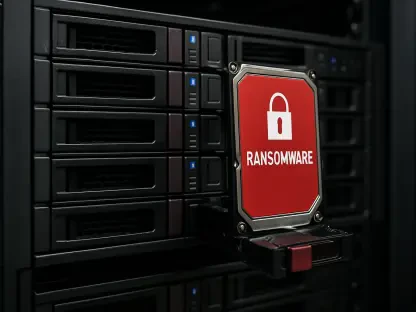On September 12, 2024, a significant cybersecurity incident rocked Fortinet, a leading firm in the industry based in Sunnyvale, California. The incident came to light when a hacker, operating under the alias “Fortibitch,” publicly claimed responsibility for infiltrating Fortinet’s Azure SharePoint system and stealing an eye-popping 440 GB of data. Referring to this massive breach as “Fortileak,” the hacker went a step further by sharing access credentials to the pilfered data on Breach Forum, a notorious underground platform frequented by cybercriminals. This breach has not only compromised a vast amount of sensitive data but has also ignited grave concerns regarding the robustness of Fortinet’s own cybersecurity measures.
Details of the Breach
The breach was traced to a vulnerability in Fortinet’s Azure SharePoint instance, revealing a significant security weakness within the company’s cloud infrastructure. Exploiting this weakness, the hacker known as Fortibitch managed to gain unauthorized access to highly sensitive company data. This stolen data, reportedly stored on an Amazon S3 bucket, was subsequently leaked online, making it readily available for further unauthorized dissemination. The sheer volume of the data leak, combined with Fortinet’s standing as a foremost cybersecurity firm, has raised critical questions about the integrity of the company’s security frameworks.
Fortibitch’s actions have cast a shadow on Fortinet’s reputation, especially given the company’s role in providing security solutions to other enterprises. By broadcasting the access credentials on an infamous underground forum, the hacker widened the potential for further malicious activities, exposing not only Fortinet but also its clients to increased cybersecurity risks. This incident has underscored a pressing need for companies, even those specializing in cybersecurity, to regularly review and bolster their security protocols to defend against sophisticated cyber threats.
Hacker’s Objectives and Negotiation Attempts
Beyond merely leaking the data, the hacker attempted to use their illicit gains to extort Fortinet. Fortibitch sought to engage in ransom negotiations directly with Fortinet’s CEO, Ken Xie, showcasing a brazen approach aimed at leveraging the stolen data for financial gain. However, these talks ultimately broke down, according to communications shared by the hacker. The hacker’s messages were laced with taunts and ridicule, clearly revealing a disdainful and defiant attitude toward Fortinet’s leadership. This tone suggested that beyond financial motives, there was also an intent to publicly embarrass the company.
The failed negotiation attempts and subsequent public disclosure highlight a layered strategy often employed by cybercriminals, combining financial extortion with reputational damage. Fortibitch’s open mockery of the negotiations with Ken Xie serves as a stark reminder of the complex dynamics and psychological tactics at play in modern cyber threats. By publicizing the failed talks and the breach details, the hacker not only aimed to pressure Fortinet but also to signal to other potential victims their willingness to expose sensitive information if demands are not met.
Fortinet’s Reaction to the Breach
In the wake of the breach, Fortinet’s reaction has been a blend of acknowledgment and downplaying the incident. The company confirmed that unauthorized access had indeed occurred but insisted that the scope of the data compromised was limited. According to a spokesperson, the affected data pertained to a minor subset of their clientele, and there had been no detected malicious activity within their operational framework. These reassurances, however, have done little to quell the widespread concern sparked by the enormous volume of data involved in the breach and Fortinet’s prominent role in the cybersecurity industry.
Despite the attempt to downplay the breach’s impact, the incident has inevitably cast a spotlight on Fortinet’s security vulnerabilities. The confirmation of the limited subset of data affected may aim to contain immediate panic, but the breach’s implications are far-reaching, given the firm’s stature and the potential ramifications for client trust and future business prospects. This incident has undeniably posed a significant challenge to Fortinet’s credibility and has emphasized the need for stronger, more transparent communication with stakeholders during such crises.
Fortinet’s Mitigation Strategies
In response to the breach, Fortinet promptly initiated an investigation to assess and mitigate the damage. The company succeeded in terminating the unauthorized access and promptly notified law enforcement as well as relevant cybersecurity agencies. In a bid to fortify their defenses, Fortinet has since enhanced its internal security protocols. This includes the implementation of improved account monitoring systems and advanced threat detection measures. Fortinet maintains that these swift actions have cushioned the overall impact of the breach and are instrumental in preventing similar occurrences in the future.
These mitigation strategies underscore Fortinet’s commitment to rectifying the situation and reinforcing their security measures. The company’s proactive approach in engaging law enforcement and cybersecurity agencies highlights a comprehensive strategy aimed at both immediate damage control and long-term prevention. By bolstering internal security protocols, Fortinet aims to restore confidence among its clients and stakeholders and to exemplify best practices in incident response for the broader cybersecurity industry.
History of Security Incidents
This recent breach is by no means an isolated incident for Fortinet, as the company has previously faced multiple cybersecurity challenges. Among these, a notable attack involved Chinese hackers exploiting a zero-day vulnerability in Fortinet’s products. Additionally, another significant incident saw the exploitation of a vulnerability in FortiOS, Fortinet’s security appliance operating system. These recurring breaches paint a sobering picture of the persistent and evolving nature of cyber threats that the firm must continually defend against.
The historical context of previous security incidents at Fortinet highlights the ongoing difficulties faced by even leading cybersecurity firms in safeguarding their infrastructures. Each breach, including the latest Fortileak, serves as a critical learning point, emphasizing the necessity for continuous improvement and updating of security protocols. The recurrence of such incidents demonstrates the relentless pace at which cyber threats are advancing and the imperative for constant vigilance and innovation in defense strategies.
Broader Impact on the Cybersecurity Industry
The Fortileak incident serves as a stark reminder of the inherent vulnerabilities within the cybersecurity industry, even among its most esteemed leaders. It underscores the critical need for robust, continually updated security measures, particularly as cloud services become increasingly ubiquitous. This breach has ignited discussions on best practices, emerging threats, and the necessity for vigilant and adaptive security strategies in the face of rapidly evolving cyber risks. It is a call to arms for the entire industry to enhance their defensive postures and ensure the adequacy of their protective measures.
While Fortinet’s breach is a singular event, its implications ripple across the entire cybersecurity landscape, provoking broader industry-wide reflections on existing security frameworks and risk management strategies. The incident has underscored that no organization, irrespective of its expertise or reputation, is immune to cyber threats. Consequently, it emphasizes the importance for continuous refinement of security protocols, fostering collaboration among cybersecurity professionals, and adopting a proactive stance towards threat detection and mitigation to prevent similar incidents in the future.
Regulatory and Compliance Considerations
The hacker’s reference to the SEC 8-K form, which mandates disclosure of major incidents by public companies, brings to the forefront significant regulatory and compliance considerations. This aspect of the breach highlights the importance of transparency and timely reporting to regulators and investors. It raises pertinent questions about the adequacy of existing accountability mechanisms and the effectiveness of Fortinet’s incident disclosure practices. Companies are reminded of the critical need to adhere to regulatory expectations following a cyber incident, ensuring that stakeholders are kept informed promptly and accurately.
The mention of the SEC 8-K form underscores a broader challenge for public companies in maintaining regulatory compliance amidst an ever-increasing landscape of cyber threats. It brings into focus the need for clear, effective communication channels and robust governance frameworks to manage the fallout of cybersecurity incidents. As regulatory scrutiny intensifies and stakeholders demand greater transparency, firms must navigate the complexities of immediate incident response alongside long-term compliance and reputational management.
Industry and Community Reactions
Although specific reactions from the industry and the cybersecurity community were not detailed in the initial reports, it’s reasonable to infer that Fortinet’s breach would have caused a significant ripple of concern among professionals and customers alike. An incident of this magnitude, involving one of the industry’s leading firms, is bound to trigger broader discussions on the evolving nature of cyber threats and the efficacy of existing protective measures. This breach serves as a wake-up call about the importance of ongoing vigilance and the need for robust, adaptive defense strategies in the cybersecurity domain.
The Fortinet breach not only alarms its direct stakeholders but also reverberates through the wider cybersecurity and tech communities. It challenges professionals to reassess and reinforce their own security postures, promoting a culture of continuous improvement and proactive defense. Such incidents can act as catalysts for industry-wide advancements, driving innovation in threat detection and response capabilities, and fostering collaboration to tackle the sophisticated nature of modern cyber threats effectively.
Future Security Measures and Best Practices
The breach has ignited widespread concern about the effectiveness of Fortinet’s security measures and has prompted discussions among industry experts and clients alike regarding the robustness of current cybersecurity protocols. On September 12, 2024, Fortinet, a prominent cybersecurity company located in Sunnyvale, California, faced a major security breach when a hacker going by the alias “Fortibitch” claimed to have successfully infiltrated Fortinet’s Azure SharePoint system, stealing an astonishing 440 GB of data. Dubbed “Fortileak,” this alarming incident became public when the hacker shared access credentials to the stolen data on Breach Forum, a notorious platform frequented by cybercriminals. The unauthorized access to such a vast amount of sensitive information not only raises questions about Fortinet’s cybersecurity defenses but also poses severe risks to its clients and their data confidentiality. As investigations continue, the incident serves as a stark reminder of the persistent threats in the digital age and the need for constant vigilance in safeguarding sensitive information.









